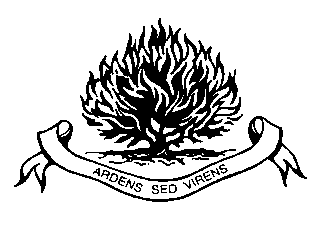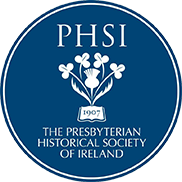 The Burning Bush as a symbol of the suffering but living Church is one of the most frequently seen symbols in the congregations of the Presbyterian Church in Ireland, appearing on pulpit falls and carved on communion tables, chairs, and other furnishings.
The Burning Bush as a symbol of the suffering but living Church is one of the most frequently seen symbols in the congregations of the Presbyterian Church in Ireland, appearing on pulpit falls and carved on communion tables, chairs, and other furnishings.
Little is known of the origin of the use of the Burning Bush as a symbol of the Reformed Church and Presbyterianism. One of the earliest references comes from the writing of John Quick in his 2 volume work ‘Synodicon in Gallia Reformata’, (1692), a collection of the acts of the Synods of the French Reformed Church. Twice in this work he states ‘There is engraven on the Seal a Burning Bush and ..... round the circle Flagror non consumor’ and again he speaks of a ‘bramble-bush in a flaming fire...and the motto Comburo non Consumor’. The seal he refers to was for the 12th National Synod of the French Reformed Church in 1583. However, no seal or document with an impression is extant. The earliest use of the emblem in Scotland is on the title page of the book ‘The Joy of Tears’ by William Mure published in 1635 where it is introduced with reference to the troubles of the Kirk. It appears again as the frontispiece to a pamphlet published in London in 1642 - a picture of the Burning Bush with an accompanying motto Quamvis urornon comburor. In 1691 we find it printed for the first time in the title page of the Acts of the General Assembly of the Church of Scotland and was accompanied by the words ‘Nec Tamen Consumebatur'.
 The earliest Irish use of a burning bush symbol was in the first edition of the twice weekly Presbyterian newspaper The Banner of Ulster, published on 10th June 1842 (the 200th anniversary of the first Presbytery meeting at Carrickfergus). The editor, Rev William Gibson (of Third Belfast and later Professor of Ethics in the Presbyterian College, Belfast, and author of ‘The Year of Grace’ on the 1859 Revival), established the newspaper to ‘guide public opinion on the relation of Church and State in the disruption controversy in the Church of Scotland and to uphold orthodox Presbyterian principles’. The newspaper featured a burning bush with an open Bible beneath. On either side of the bush was an Irish wolfhound, an Irish harp and a round tower in the background with the shamrock and thistle intertwined. Above the symbols are the word ‘Ardens Sed Virens’ (Burning but Flourishing). The symbols point to the fact that the Presbyterian Church in Ireland is founded on the Scriptures, that it has links with the mother Church in Scotland and that its life is in Ireland. This symbol would appear to be the first linking of the Burning Bush with the words ‘Ardens Sed Virens’.
The earliest Irish use of a burning bush symbol was in the first edition of the twice weekly Presbyterian newspaper The Banner of Ulster, published on 10th June 1842 (the 200th anniversary of the first Presbytery meeting at Carrickfergus). The editor, Rev William Gibson (of Third Belfast and later Professor of Ethics in the Presbyterian College, Belfast, and author of ‘The Year of Grace’ on the 1859 Revival), established the newspaper to ‘guide public opinion on the relation of Church and State in the disruption controversy in the Church of Scotland and to uphold orthodox Presbyterian principles’. The newspaper featured a burning bush with an open Bible beneath. On either side of the bush was an Irish wolfhound, an Irish harp and a round tower in the background with the shamrock and thistle intertwined. Above the symbols are the word ‘Ardens Sed Virens’ (Burning but Flourishing). The symbols point to the fact that the Presbyterian Church in Ireland is founded on the Scriptures, that it has links with the mother Church in Scotland and that its life is in Ireland. This symbol would appear to be the first linking of the Burning Bush with the words ‘Ardens Sed Virens’.
In 1851 the symbol in The Banner of Ulster had changed to a flag with just a burning bush, the red hand and a shamrock wreath with the words ‘Ardens Sed Virens’ underneath. After 1865 the symbol no longer appears in The Banner and the publication ceased about 5 years later. The symbol was later simplified to the now more familiar burning bush and the Latin inscription underneath.
